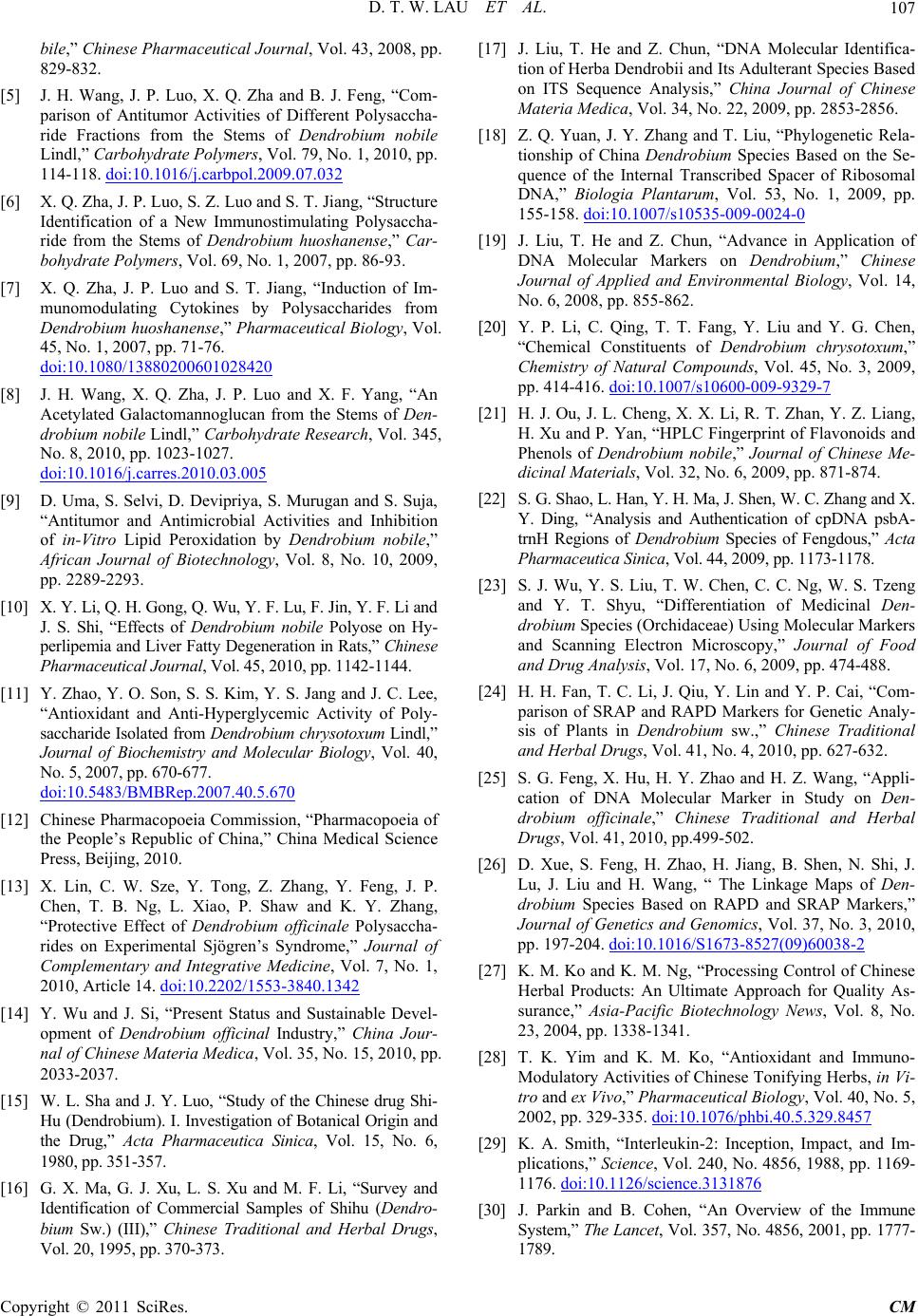
D. T. W. LAU ET AL.107
bile,” Chinese Pharmaceutical Journal, Vol. 43, 2008, pp.
829-832.
[5] J. H. Wang, J. P. Luo, X. Q. Zha and B. J. Feng, “Com-
parison of Antitumor Activities of Different Polysaccha-
ride Fractions from the Stems of Dendrobium nobile
Lindl,” Carbohydrate Polymers, Vol. 79, No. 1, 2010, pp.
114-118. doi:10.1016/j.carbpol.2009.07.032
[6] X. Q. Zha, J. P. Luo, S. Z. Luo and S. T. Jiang, “Structure
Identification of a New Immunostimulating Polysaccha-
ride from the Stems of Dendrobium huoshanense,” Car-
bohydrate Polym ers, Vol. 69, No. 1, 2007, pp. 86-93.
[7] X. Q. Zha, J. P. Luo and S. T. Jiang, “Induction of Im-
munomodulating Cytokines by Polysaccharides from
Dendrobium huoshanense,” Pharmaceutical Biology, Vol.
45, No. 1, 2007, pp. 71-76.
doi:10.1080/13880200601028420
[8] J. H. Wang, X. Q. Zha, J. P. Luo and X. F. Yang, “An
Acetylated Galactomannoglucan from the Stems of Den-
drobium nobile Lindl,” Carbohydrate Research, Vol. 345,
No. 8, 2010, pp. 1023-1027.
doi:10.1016/j.carres.2010.03.005
[9] D. Uma, S. Selvi, D. Devipriy a, S. Murugan and S. Suja,
“Antitumor and Antimicrobial Activities and Inhibition
of in-Vitro Lipid Peroxidation by Dendrobium nobile,”
African Journal of Biotechnology, Vol. 8, No. 10, 2009,
pp. 2289-2293.
[10] X. Y. Li, Q. H. Gong , Q. Wu, Y. F. Lu, F. Jin, Y. F. Li and
J. S. Shi, “Effects of Dendrobium nobile Polyose on Hy-
perlipemia and Liver Fatty Degeneration in Rats,” Chinese
Pharmaceutical Journal, Vol. 45, 2010, pp. 1142-1144.
[11] Y. Zhao, Y. O. Son, S. S. Kim, Y. S. Jang and J. C. Lee,
“Antioxidant and Anti-Hyperglycemic Activity of Poly-
saccharide Isolated from Dendrobium chrysotox um Lindl,”
Journal of Biochemistry and Molecular Biology, Vol. 40,
No. 5, 2007, pp. 670-677.
doi:10.5483/BMBRep.2007.40.5.670
[12] Chinese Pharmacopoeia Commission, “Pharmacopoeia of
the People’s Republic of China,” China Medical Science
Press, Beijing, 2010.
[13] X. Lin, C. W. Sze, Y. Tong, Z. Zhang, Y. Feng, J. P.
Chen, T. B. Ng, L. Xiao, P. Shaw and K. Y. Zhang,
“Protective Effect of Dendrobium officinale Polysaccha-
rides on Experimental Sjögren’s Syndrome,” Journal of
Complementary and Integrative Medicine, Vol. 7, No. 1,
2010, Article 14. doi:10.2202/1553-3840.1342
[14] Y. Wu and J. Si, “Present Status and Sustainable Devel-
opment of Dendrobium officinal Industry,” China Jour-
nal of Chinese Materia Medica, Vol. 35, No. 15, 2010, pp.
2033-2037.
[15] W. L. Sha and J. Y. Luo, “Study of the Chinese drug Shi-
Hu (Dendrobium). I. Inve stigation of Botanical Origin and
the Drug,” Acta Pharmaceutica Sinica, Vol. 15, No. 6,
1980, pp. 351-357.
[16] G. X. Ma, G. J. Xu, L. S. Xu and M. F. Li, “Survey and
Identification of Commercial Samples of Shihu (Dendro-
bium Sw.) (III),” Chinese Traditional and Herbal Drugs,
Vol. 20, 1995, pp. 370-373.
[17] J. Liu, T. He and Z. Chun, “DNA Molecular Identifica-
tion of Herba Dendrobii and Its Adulterant Species Based
on ITS Sequence Analysis,” China Journal of Chinese
Materia Medica, Vol. 34, No. 22, 2009, pp. 2853-2856.
[18] Z. Q. Yuan, J. Y. Zhang and T. Liu, “Phy logenetic Rela-
tionship of China Dendrobium Species Based on the Se-
quence of the Internal Transcribed Spacer of Ribosomal
DNA,” Biologia Plantarum, Vol. 53, No. 1, 2009, pp.
155-158. doi:10.1007/s10535-009-0024-0
[19] J. Liu, T. He and Z. Chun, “Advance in Application of
DNA Molecular Markers on Dendrobium,” Chinese
Journal of Applied and Environmental Biology, Vol. 14,
No. 6, 2008, pp. 855-862.
[20] Y. P. Li, C. Qing, T. T. Fang, Y. Liu and Y. G. Chen,
“Chemical Constituents of Dendrobium chrysotoxum,”
Chemistry of Natural Compounds, Vol. 45, No. 3, 2009,
pp. 414-416. doi:10.1007/s10600-009-9329-7
[21] H. J. Ou, J. L. Cheng, X. X. Li, R. T. Zhan, Y. Z. Liang,
H. Xu and P. Yan, “HPLC Fingerprint of Flavonoids and
Phenols of Dendrobium nobile,” Journal of Chinese Me-
dicinal Materials, Vol. 32, No. 6, 2009, pp. 871-874.
[22] S. G. Sha o, L. Han, Y. H. Ma, J. S hen, W. C. Zhang and X.
Y. Ding, “Analysis and Authentication of cpDNA psbA-
trnH Regions of Dendrobiu m Species of Fengdous,” Acta
Pharmaceutica Sinica, Vol. 44, 2009, pp. 1173-1178.
[23] S. J. Wu, Y. S. Liu, T. W. Chen, C. C. Ng, W. S. Tzeng
and Y. T. Shyu, “Differentiation of Medicinal Den-
drobium Species (Orchidaceae) Using Molecular Markers
and Scanning Electron Microscopy,” Journal of Food
and Drug Analysis, Vol. 17, No. 6, 2009, pp. 474-488.
[24] H. H. Fan, T. C. Li, J. Qiu, Y. Lin and Y. P. Cai, “Com-
parison of SRAP and RAPD Markers for Genetic Analy-
sis of Plants in Dendrobium sw.,” Chinese Traditional
and Herbal Drugs, Vol. 41, No. 4, 2010, pp. 627-632.
[25] S. G. Feng, X. Hu, H. Y. Zhao and H. Z. Wang, “Appli-
cation of DNA Molecular Marker in Study on Den-
drobium officinale,” Chinese Traditional and Herbal
Drugs, Vol. 41, 2010, pp.499-502.
[26] D. Xue, S. Feng, H. Zhao, H. Jiang, B. Shen, N. Shi, J.
Lu, J. Liu and H. Wang, “ The Linkage Maps of Den-
drobium Species Based on RAPD and SRAP Markers,”
Journal of Genetics and Genomics, Vol. 37, No. 3, 2010,
pp. 197-204. doi:10.1016/S1673-8527(09)60038-2
[27] K. M. Ko and K. M. Ng, “Processing Control of Chinese
Herbal Products: An Ultimate Approach for Quality As-
surance,” Asia-Pacific Biotechnology News, Vol. 8, No.
23, 2004, pp. 1338-1341.
[28] T. K. Yim and K. M. Ko, “Antioxidant and Immuno-
Modulatory Activities of Chinese Tonifying Herbs, in Vi-
tro and ex Vivo,” Pharmaceutical Biology, Vol. 40, No. 5,
2002, pp. 329-335. doi:10.1076/phbi.40.5.329.8457
[29] K. A. Smith, “Interleukin-2: Inception, Impact, and Im-
plications,” Science, Vol. 240, No. 4856, 1988, pp. 1169-
1176. doi:10.1126/science.3131876
[30] J. Parkin and B. Cohen, “An Overview of the Immune
System,” The Lancet, Vol. 357, No. 4856, 2001, pp. 1777 -
1789.
Copyright © 2011 SciRes. CM